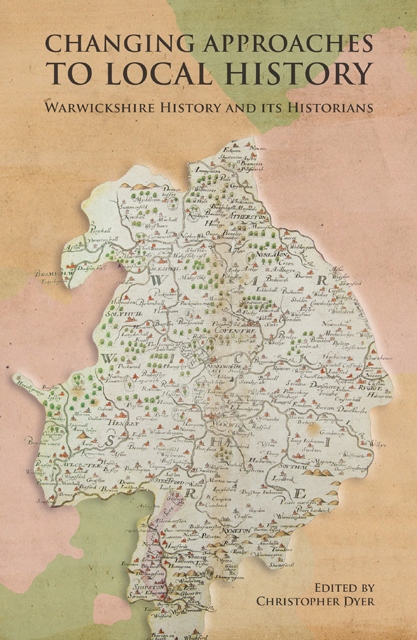Book contents
- Frontmatter
- Contents
- List of Illustrations
- Notes on Contributors
- Foreword
- Acknowledgements
- List of Abbreviations
- Introduction
- 1 The Dugdale Society: Its First Hundred Years
- 2 The Beginnings of Coventry
- 3 Was Commerce in Late Medieval Coventry Restricted by Regulation?
- 4 Studying Late Medieval Small Towns in Warwickshire 1920–2020
- 5 Rural Warwickshire in the Middle Ages: Society and Landscape
- 6 Religion, Rebellion and Red Jackets: Changing Approaches to Society and Politics in Sixteenth-century Warwickshire
- 7 Social Networks, Intellectual Affinities and Communal Harmony in Post-Reformation Warwickshire
- 8 Discovering Warwickshire’s Vernacular Architecture
- 9 Local History and the English Civil War: A View from Warwickshire
- 10 Writing Histories of the Landed Elite in Georgian Warwickshire
- 11 The Victoria County History in Warwickshire
- 12 Writing Women into the Political History of Warwickshire
- 13 Shakespeare and the Warwickshire Landscape in the Age of the Tourist
- Conclusion
- Index
13 - Shakespeare and the Warwickshire Landscape in the Age of the Tourist
Published online by Cambridge University Press: 17 December 2022
- Frontmatter
- Contents
- List of Illustrations
- Notes on Contributors
- Foreword
- Acknowledgements
- List of Abbreviations
- Introduction
- 1 The Dugdale Society: Its First Hundred Years
- 2 The Beginnings of Coventry
- 3 Was Commerce in Late Medieval Coventry Restricted by Regulation?
- 4 Studying Late Medieval Small Towns in Warwickshire 1920–2020
- 5 Rural Warwickshire in the Middle Ages: Society and Landscape
- 6 Religion, Rebellion and Red Jackets: Changing Approaches to Society and Politics in Sixteenth-century Warwickshire
- 7 Social Networks, Intellectual Affinities and Communal Harmony in Post-Reformation Warwickshire
- 8 Discovering Warwickshire’s Vernacular Architecture
- 9 Local History and the English Civil War: A View from Warwickshire
- 10 Writing Histories of the Landed Elite in Georgian Warwickshire
- 11 The Victoria County History in Warwickshire
- 12 Writing Women into the Political History of Warwickshire
- 13 Shakespeare and the Warwickshire Landscape in the Age of the Tourist
- Conclusion
- Index
Summary
This chapter is part of a larger project on relationships with the Warwickshire landscape between the sixteenth and the twentieth centuries. That work aims to establish how and why people passed through the county’s green spaces, what physical interactions they had with them – for instance walking (primarily, but also more broadly moving through on horses, barges, trains, cars and planes), digging (for crops and archaeological finds), surveying and quantifying (mapping, photographing and assessing the landscape and its minerals, water, flora and fauna) – and how people represented those interactions in words or images. In what follows, I focus on a small part of those larger concerns, temporally and generically: the development of touristic travel books across the nineteenth century. My aim is to address, through an analysis of the range and focus of such publications, the role that Warwickshire’s landscape played in making the identity of the county more tangible, through the efforts of those artists who wrote and drew it into public consciousness.
In considering such questions, this chapter traces two arcs that meet as the Dugdale Society was being set up – the development of the genre of travel books on the Warwickshire landscape, expanding to reflect new modes of transport and touristic behaviour, and the emergence of academic study of the landscape which has got under way in the century since. It is this latter subject to which the chapter first turns. In the space available it is possible to offer only a swift outline of five broad areas in two broader groups, focused on key publications within them: writing on maps, agrarian change, the social consequences of that change, the aestheticisation of landscape and the rise of tourism.
In the Preface to Harvey and Thorpe’s 1959 Printed Maps of Warwickshire, R. A. Skelton of the British Museum stated that,
The traditional attachment of the Englishman to his county has strong roots in its geography and history. The English shire is much more than an ancient administrative district. It has … a distinctive physical character, and within their boundaries its people have created a social life similar in structure to that of their neighbours but different in idiom.
- Type
- Chapter
- Information
- Publisher: Boydell & BrewerPrint publication year: 2022

